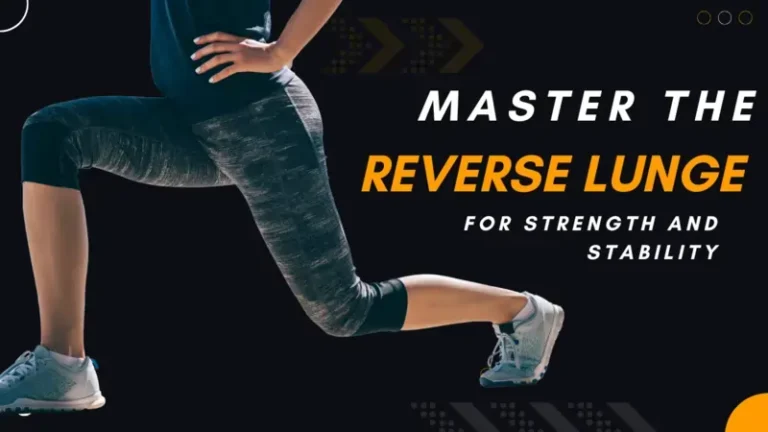Hack Squat Exercise
Table of Contents
Introduction
Hack squats are a type of leg exercise designed to build strength and muscle mass in the lower body, particularly targeting the quadriceps, hamstrings, and glutes.
It’s a powerful compound movement that works the lower back and core muscles as well. Most often, a specialized machine made to mimic a squat motion while supporting the back and neck is used to perform the hack squat.
Traditional squat variations that target different muscles and advanced levels will help you achieve next-level gains in leg strength. Discover hack squat variations that challenge every leg muscle, from the core to the calves, to build a balanced lower body for an intense and efficient workout.
Later on, your front legs will be the ones who suffer from your increased focus on your quadriceps. Include the hack squat in your exercise regimen if you want to increase the size of your quadriceps and other leg muscles.
However, hack squats use the same joint movement as a regular squat but concentrate primarily on the hip joint. To do the hack squat, you must stand on a fixed platform and descend normally.
Unlike other exercises, hack squats concentrate the tension on the targeted muscles while utilizing stable machinery, which significantly lessens the need for stabilizing muscles and ensures everyone’s safety.
Muscles Activated in the Hack Squat:
It’s crucial to carefully employ the appropriate muscles when performing the hack squat. Radiating stress through your muscles helps you lift weight and safeguard your joints.
- Quads: The weight placement in the hack squat during this exercise will draw more attention to your anterior chain and quadriceps. Your quadriceps are in charge of your knee flexion when you lower yourself from a squat and your hip extension when you stand up.
- Hamstrings: The hack squat will work your hamstrings and posterior cord, but not as much as other exercises like the deadlift. To guarantee complete body engagement and tension, it’s crucial to contract your hamstrings throughout the hack squat.
- Glutes: The gluteus maximus, gluteus minimus, and gluteus medius make up this powerful muscular group.Strong glutes let you lift weights safely by stabilizing your hips and supporting your hip flexion in the hack squat. Your glutes also help in hip extension. In your Hack a Squat, adopt a firm stance and notice how your quadriceps, hamstrings, and glutes work together to extend your hips.
- Core: The transverse and rectus abdominis muscles, which are located at the front of your body, make up your core. Included are the obliques that encircle your body from the inside out. During the hack squat, you should fully contract all of your core muscles to prevent your spine from moving under pressure.
Benefits of the key Hack Squat:
It is easy for beginners to perform:
The machine-supported hack squat requires little instruction on form or technique, even for beginners. Because the machine continuously stabilizes you, you are less likely to make a mistake or lose form when performing a hack squat.
Build Your Quads:
Attempting a bodyweight hack squat will make your quadriceps tighten up right away.
If you can perform a lot of repetitions at a moderate weight during your workout, you will gain some significant shape.
Easy to set up:
It is similar to a reverse leg press in that you just add weight plates to the machine, which reduces the effort of using a barbell and squat rack together.
Provides Stability:
Hack squats maintain your hips and upper back in a solid position, in contrast to free-weight squats, which demand a lot of core stability.
For added stability, you can also try barbell back squats if you’re new to the weight room.
Because you cannot tumble forward or backward and you do not need to balance free weights, hack squats are likely less hazardous than barbell squats. This is particularly valid if you have never worked out before.
Reducing Load on the spine:
Exercises that work the lower body well but also require a lot of upper body strength and mobility are barbell front and back squats.
They are made with the intention of heavily taxing your spine, particularly your upper back.
If you want to squat hard with a barbell while giving your upper body a break, the hack squat can be a helpful alternative.
Improve Athletic Performance:
Hack squats are an excellent exercise for runners and other athletes who must run quickly for their sport.
Your entire focus will be on moving weight with your lower body. It will strengthen your legs, glutes, and feet.
You can work your feet and glutes with hack squats, and for speed training or other sports, you should always plant your feet correctly.
Improve Mobility:
The hack squat demands your shoulders to be extended, but it does so with less flexion than the front or back squats. Their range of motion may be improved by removing weight from that region.
Lower Body Strength:
Large weights can be used to effectively perform the hack squat because it works the quadriceps, hamstrings, and glutes.
Hack squats are a great way to strengthen your lower body without overtaxing your lower back like barbell squats or deadlifts do. This is because working on your legs will put less stress on your lower back.
Knee Strengthening:
Given that the hack squat is widely acknowledged to have a significant impact on the knee, many weightlifters avoid performing the exercise altogether. However, in healthy individuals experiencing knee issues, this could apply beneficial strain to the knee’s connective tissues, which could result in long-term improvements in joint health.
Just like with muscles, lifters need to develop the ability to tolerate some discomfort in order to strengthen any joint.
Applying (acceptable) stress to the joint is the best way to increase joint strength; progressive volume, appropriate loading, and good technique can help achieve this.
Hack Squat Drawbacks:
Put some pressure on your knees: Hack squats can be very taxing on the knee joint, especially if they are done incorrectly or with too much weight. Avoiding knee pain or injury requires paying close attention to form and gradually increasing the weight load.
Not appropriate for all individuals: Hack squats may not be the best exercise for people who are new to resistance training. For those who are new to strength training, hack squats can be difficult exercises to perform because they can result in incorrect form and a higher risk of injury.
Who Needs to Perform the Hack Squat?
Beginners: The hack squat is a good exercise for people who are new to lifting and squatting because it teaches proper form by keeping the torso elevated and requiring some core engagement without a heavy load. It’s also a great way to improve hip flexibility, which is a crucial training skill but can be very challenging at first. Because of where the bar is placed, you have to slightly bend your hips before squatting down. Even a beginner can learn how to do this exercise without a barbell.
Bodybuilders: Bodybuilders engage in a lot of focused exercises to target particular muscles and cause them to show and grow. They also need to work on compound exercises and keep their entire body coordinated well. This is where the squat and other functional exercises come in handy.
PowerliftersThe main goals of powerlifters are to get more reps out of the bench press, deadlift, and squat. Your main lifts will eventually benefit from the increased leg strength you get from the hack squat, which will also help you reach your powerlifting goals.
How to Perform Hack Squats Correctly:
Machine setup: To begin, set the hack squat machine to your preferred height and degree of comfort. A comfortable shoulder rest on the shoulder pads and hip-width apart feet on the platform are important to check.
- Foot placement: Put your toes slightly outside and place your feet on the platform somewhat lower than your hips. This will make it easier for you to target your quadriceps.
- Grip the handles: Throughout the workout, grasp onto the machine’s supplied handles for balance and control.
- Implementing: With your back against the pad, flex your knees to gradually lose weight. Your knees and toes should align as you drop.
- Pushing up: Put pressure on your heels to bring the weight back to its initial position. Check to make sure your knees are not locked.
- Repetitions: Once you’ve established your fitness level, change the weight to get 8–12 repetitions.
Hack Squat Exercise Variations:
Your body is locked into a rigid, static posture by the hack squat machine, making it challenging to modify and increase the workout. Your exercise regimen must contain the correct variation of the squat.
Hack squat with Smith Machine
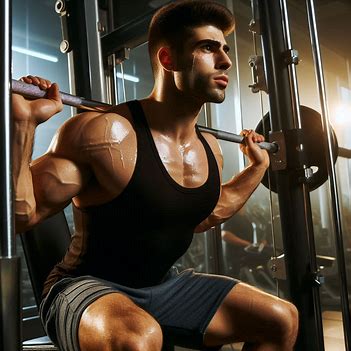
While standing, place the bar slightly behind your legs, maintain a shoulder-width distance between your feet, and point your toes forward.
Extending your hips and knees is necessary to raise the bar, but be careful not to lock your knees.
Maintain this position for some time.
Gently revert to your starting position.
Next, relax.
Do this for eight to ten repetitions.
Reverse hack squat:
First, the shoulder pads’ height needs to be changed.
They should be just below chest height, requiring you to bend your knees slightly to get down.
Choose a weight that will challenge you enough so that you can perform several sets with accurate form.
Place your feet near the base of the platform so that there is just enough room between them and the machine so that your knees can bend easily.
You can let go of the weight once you are standing straight and have fully extended your knees.
You can center your body by shifting where your feet are on the platform.
Squat down and stretch your knees and shins well past your toes to begin lowering your body to begin reaching the platform.
Let your hips drop as you recline.
If you allow your butt to drop below your knees, your quadriceps will contract severely.
After a brief period of holding at the bottom of the action, carefully bring your hips and knees back to the starting position.
At the peak of the exercise, keep your hips and knees slightly bent to maintain continuous quad tension.
Next, relax.
Do this for eight to ten repetitions.
Narrow hack squat
Start by pulling your shoulders under and lowering your back on the hack squat machine’s back pads.
Next, place your legs less than shoulder-width apart in a very narrow stance with your toes pointed out.
Start lowering the machine while bending your knees, then extend your legs without locking your knees.
Hold this posture until your knees and upper legs are 90 degrees apart.
Put yourself back in your starting posture by standing up on your heels.
Next, relax.
Work out for eight to ten repetitions.
Sumo deadlift
Maintaining a wide stance, begin with your feet pointed slightly out in front of a weighted barbell.
Make sure your stance is sufficiently wide for your arms to be inside your knees. Your elbows should be slightly inside your knees as you place your hands on the bar inside your feet.
When you engage your glutes, lower back, and legs, make sure your muscles are fully contracted and your body feels as though it is on.
Make a quadriceps turn so that your femurs spin open in your hip sockets, aligning your knees with your feet and toes.
Pull up on the bar until it reaches the top of the weight plate’s inner circle while keeping your legs pushed against the floor.
For now, set the bar slightly higher.
Inhale, lift the bar, and place your legs firmly on the ground.
To elevate yourself, pull the bar as near to your body as you can while applying pressure through your heels.
As you contract your glutes to reach the top position, fully extend your hips and knees.
Reverse the movement slowly and deliberately while keeping the bar in contact with your body to avoid straining your lower back.
Next, relax.
Work out for eight to ten repetitions.
Belt Squat
A belt that is secured to a lifter’s waist by a cable is worn by them.
Subsequently, the belt traverses numerous pulleys and is fastened to a loading mechanism.
Additionally, there are machines made for belt squats that include a chain and a belt coupled with a free-weight system.
This prevents back pain and frees up the learner’s hands to perform any squat variation they choose.
Be sure your shins remain parallel to the floor when you perform hack squats with the belt machine.
Then, go back to your neutral posture.
Next, relax.
Work out for eight to ten repetitions.
Leg press machine
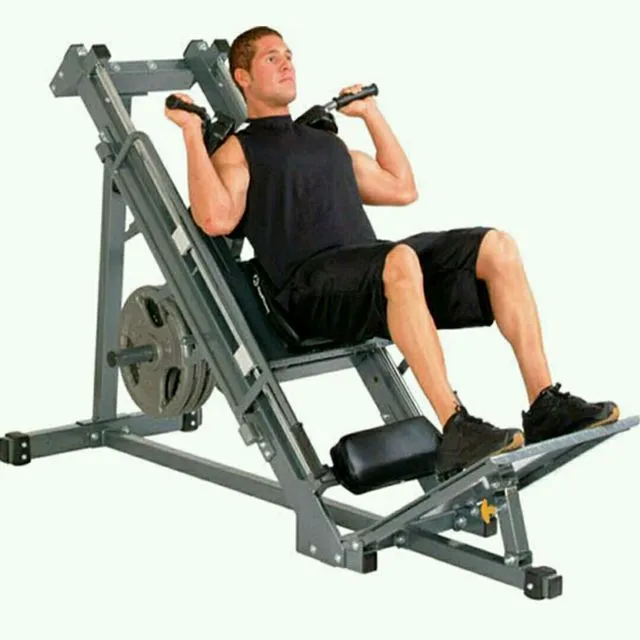
Using a leg press machine demands proper body alignment.
Your butt should be flat against the seat, not elevated.
Your knees should be parallel to your feet rather than bent inward or outward.
When you press, take care to keep this alignment.
Your head and spine will remain supported and in alignment, if you hold onto the assist handles.
Push the support away with your heels and forefoot while clenching your abs.
Remaining level on the footplate is crucial. You should never use your toes or the front of your foot alone to advance the pad.
Stretch your legs and maintain a flat back and head against the seat pad as you let go of the air.
Extend carefully and slowly rather than hastily.
Pause when the movement reaches its zenith.
Verify that you are not bending inward or outward or locking your knees.
Then, go back to your neutral posture.
Next, relax.
Work out for eight to ten repetitions.
Sissy Squat
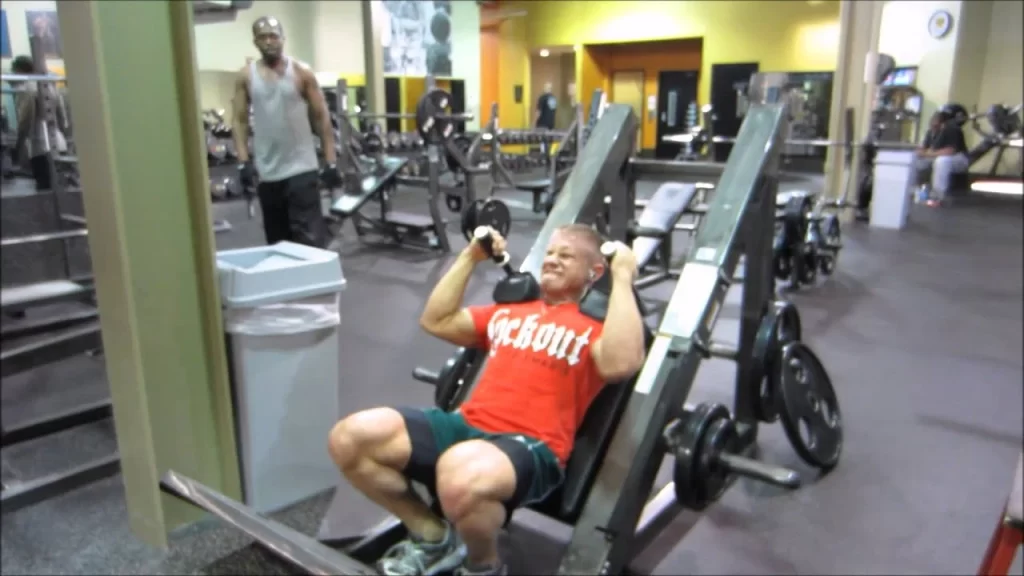
Exercises like bodyweight sissy squats are usually done first with a brace and then without one.
Step your feet so your legs are firmly against the pad and your toes are under the holders.
As much as possible, keep your torso upright.
One of the most common mistakes made by beginners is to sit back, flex their hips, and bend forward to perform a back squat.
Keep your body in an erect position so that your torso and legs are parallel to one another.
Then, go back to your neutral posture.
Next, relax.
Work out for eight to ten repetitions.
Plie Squat
Select a dumbbell or kettlebell and set it on the ground vertically.
Raise your arms straight up to the floor in a posture that is broader than shoulder width.
Hold the dumbbell or kettlebell in both hands as you crouch down.
Maintain a taut abs line and plant your feet firmly on the ground as you stand tall.
Return to the starting position gradually.
Next, relax.
Work out for eight to ten repetitions.
Heels Elevated Hack Squat
Place some weight plates or a squat wedge on the ground.
It must be possible for you to reach your toes.
Pause when the movement reaches its bottom.
Let out the breath and press through your heels to reposition yourself.
At the summit, pause and tense your quadriceps.
Next, relax.
Work out for eight to ten repetitions.
Landmine Hack Squat.
Maintain a slight bend in your knees and space your feet hip-width apart.
Maintaining an upright posture requires your shoulders to be squarely above your hips.
Your chin should remain tucked in throughout the exercise.
To establish a secure foot stance, split your weight and use your feet to grab the floor.
Using both hands, completely grasp the bar by its end.
Always keep your elbows close to your ribs. Utilize your central nervous system.
Your ribs should be down and your pelvis should be slightly pulled in.
To begin descending, bend your ankles, knees, and hips.
When your legs are either parallel to the ground or just barely off it, lower yourself.
Your feet should be evenly distributed with your weight.
Pause in the lowest position.
Press your feet into the ground as you take a step up to a standing position.
While keeping toe contact, concentrate on controlling your heel and midfoot.
As you begin to stand, lift your chest, straighten your knees and hips, and contract your glutes.
After the workout, flex your quadriceps and glutes while maintaining a neutral spine.
Next, relax.
Work out for eight to ten repetitions.
Barbell Hack Squat
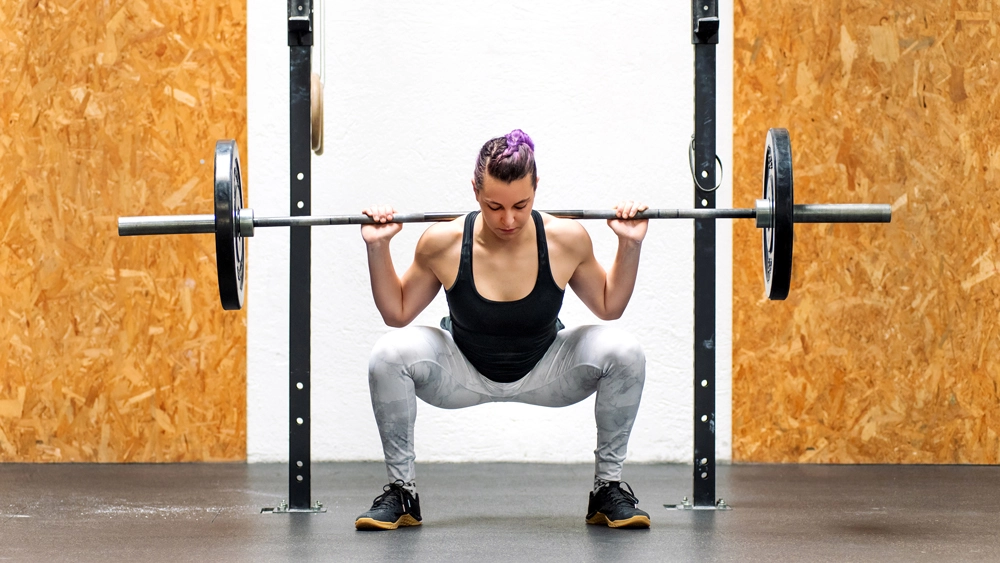
With a barbell at arm’s length behind you and your feet shoulder-width apart, take an upright stance.
Wrist wraps are an excellent way to strengthen your grip during this exercise. Here’s where you’ll begin.
Maintaining an upright stance, lower yourself until your upper thighs are parallel to the floor, maintaining your head, eyes, and back straight.
Inhale as you descend gradually.
Exhale deeply, then use your thighs and heel to propel yourself back up.
Next, relax.
Work out for eight to ten repetitions.
Goblet Squat
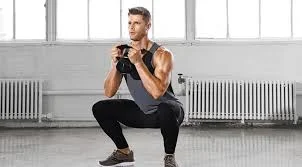
Stand with your feet slightly wider.
To ensure that the goblet is exactly in the center of your chest, bend your elbows.
Warm up with a smaller kettlebell or no weight at all to ensure you can perform the exercise.
The weight should then be raised throughout the length of the set.
You may maintain your eyes forward and your back neutrally aligned during the squat by engaging your core and gazing straight ahead.
During this descending motion, take a breath.
As you continue to push your hips back and lower yourself, concentrate on maintaining a tall chest.
The goal is to get your hips below knee parallel.
When you squat, try not to come up on your toes by keeping your weight evenly distributed across your feet or slightly more on your heels.
After squatting down, check your position.
This increases the likelihood that your knees and toes will stay in alignment when you lower yourself into a deep squat.
Return to your starting posture by repeating the exercise and pressing with your heels.
After a full set, gently drop the kettlebell. Never, ever let go of a heavy object while standing.
Next, relax.
Work out for eight to ten repetitions.
Frequent Mistakes in Hack Squats:
When doing hack squats, steer clear of these common mistakes:
bringing your heels off the floor, bending your lower back, and adding weight one little bit at a time. For best effects, concentrate on using the targeted muscles in a deliberate, calm motion.
You should slightly adjust where your feet are placed on the platform, but otherwise, your hack squat form should be the same as a traditional squat.
Make sure your feet are slightly higher up on the platform so that when you squat, you can keep your knees over your heels and maintain a good 90-degree angle between your hips and knees.
Your knees may protrude past your toes during a squat if your feet are too close to your body, which would put additional strain on your knee joints.
It’s important to remember to squat as low as you can while utilizing your whole range of motion.
With so many regulated characteristics, the hack squat machine is the perfect piece of equipment to utilize if you have a chance to squat regularly.” Stated differently, you won’t have to worry about falling or tripping over a heavy barbell if you squat too low and can’t get back up.
Tips for comfortable training and safety considerations:
Warming up and getting your muscles ready for the workout are essential. Because they target the muscles used in hack squats, stretching exercises like leg swings, walking lunges, and hip rotations are also beneficial.
Changing the Hack Squat Configuration It’s crucial to modify a hack squat machine to your specific body metrics if using one. To ensure optimal positioning and the full range of motion, make sure the shoulder pad is resting comfortably on your shoulders and upper back. Furthermore, the seat height is adjustable.
See a licensed personal trainer if you have any questions about strength training in general or hack squats in specific. A personal trainer can evaluate your current level of fitness, instruct you in appropriate form and technique, and design a personalized workout program that works with your constraints. They can also provide constructive criticism and motivation to help you improve and avoid getting hurt.
Does anyone have any reason not to participate in?
A hack squat machine’s immense adaptability makes it a machine that should fit everybody. Asking a trainer how to operate the machine for the first time is a good idea though, as it’s a big piece of machinery and you need to learn how to release the handle safely.
In general, you should avoid the hack squat if you have problems with your knees or lower back. Although the device aids in stability, the joints will still be under tension, which may exacerbate any existing problems
Summary
Hack squats are an excellent leg workout that has many benefits and can assist you in achieving your fitness goals. The primary leg muscles used during the hack squat are the quadriceps, hamstrings, and glutes.
Because they require using a barbell or a hack squat machine, they enable a more concentrated and controlled workout.
A fantastic exercise for strengthening your legs, especially your quadriceps, is the hack squat. You can also try a few variations to get even more benefits. Whether you are a novice lifter, bodybuilder, powerlifter, or somewhere in between, hack squats are a good exercise to add to your regimen.
The three most important things to focus on are form, technique, and safety when performing a hack squat with a barbell. Moreover, you should speak with a personal trainer, especially if you have never done a hack squat or strength training before.
FAQs
An effective leg workout for toning your quadriceps, glutes, and adductors is the machine hack squat. An upgraded version of the leg press and the barbell squat is the hack squat. Like the front squat or even the squat, it works your quadriceps and calls for an erect body posture, but it uses a more stable machine than the leg press.
When you work in the widest range of motion possible in the working joints, you’ll usually see greater overall benefits, such as increased strength, mobility, and muscle growth. Squat as low as you can at this point if you’re not physically able to go much lower.
Hack squats are an excellent technique to work your quadriceps, glutes, and adductors, among other leg muscles. Because of its stability and fixed range of motion, you can focus on the muscles you’re using instead of worrying about your balance. If you have trouble performing regular squats or have issues with balance or mobility, the hack squat could be a helpful substitute.
The hack squat could be just as helpful as squats for strengthening your lower body and developing your leg muscles. However, free barbell squats develop your balance and stability more effectively than hack squats.
For the hack squat, start with a weight that you can handle and complete two to three sets of eight to twelve repetitions. Choose a weight so that you can complete all sets and repetitions with the correct form.
The quadriceps, which are found in the front of the thigh, are the main muscle group that hacks squats target, but these muscles are good for leg growth in general.





